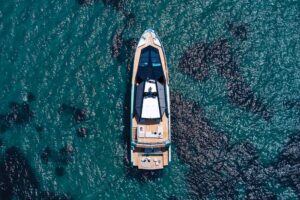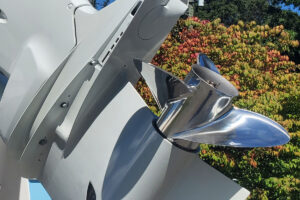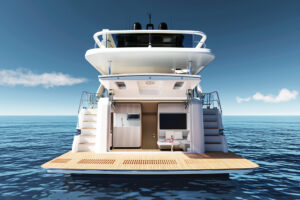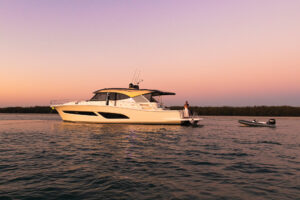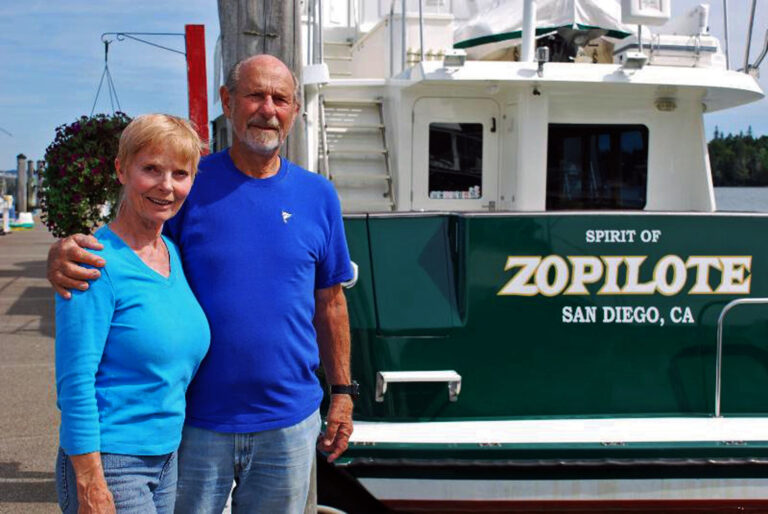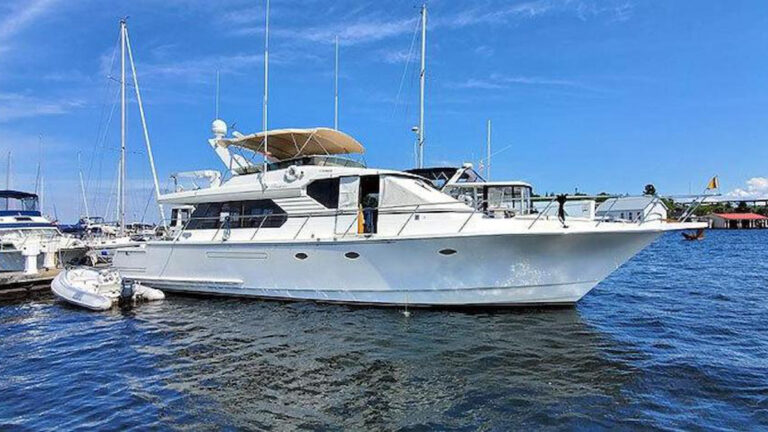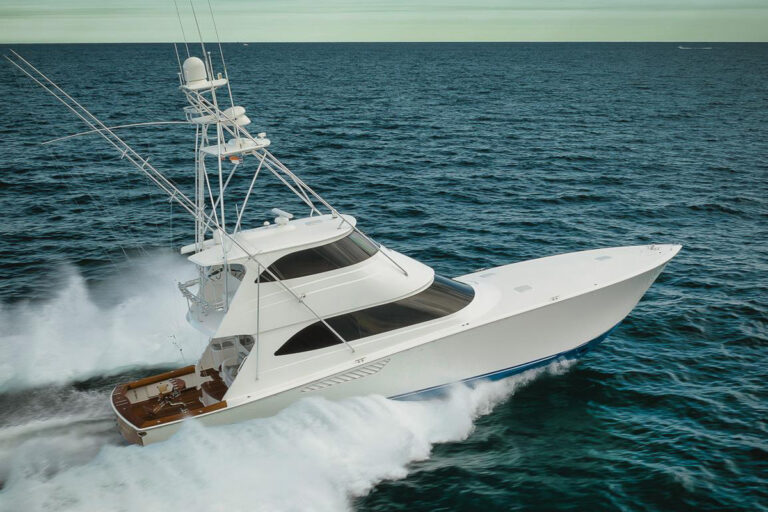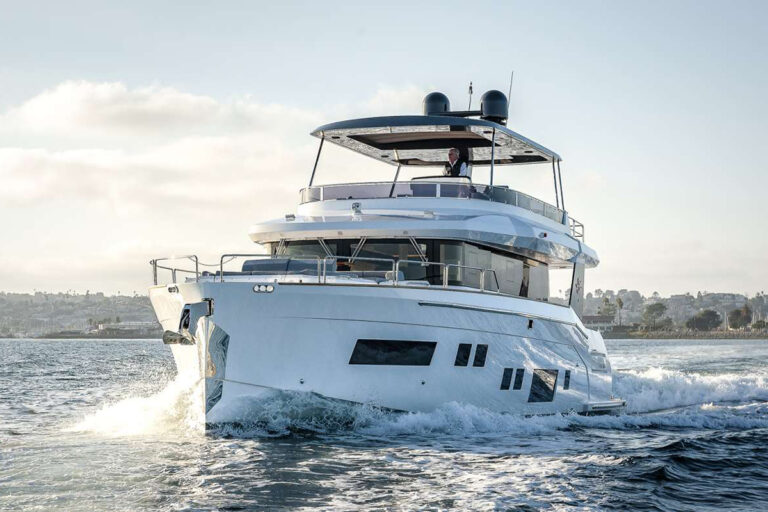I’ve had the pleasure of reviewing a few hundred boats in the past 15 years. While most have followed one well-worked formula or another, a handful were truly unique. Of these, a few wandered beyond the norm. The Brave Duck 83 qualifies for this distinguished category.
Her low silhouette, tumblehome and simple deckhouse with a laced canvas flying bridge are without a doubt classically inspired. The Brave Duck, however, delivers these traditional styling elements with a modern accent. The rake of her stem, mast and window lines suggests she is more than just a reproduction. This stimulating amalgam of old and new has been designer Tom Fexas’ signature since he penned the Midnight Lace line in the early 1980s, about the same time I worked for the firm.
While Fexas’ hand is evident in the Brave Duck’s design, she was a collaborative effort. Leopoldo Rodriquez, the son of Carlo Rodriquez, a pioneer in the development of the hydrofoil, was the catalyst for her construction.
“While the shipyards my family own have focused on creating vessels for the future, I have always been intrigued with the beauty and seakeeping ability of the designs of the past”, said Rodriquez. “Good lines make good sense whether they are old or new.”
The paths of the American designer and the Italian builder crossed when the two worked together on the development of a 50-foot sportfisherman. They soon discovered their shared passion for yachting’s golden age. Fexas was impressed with Rodriquez’s private yacht, an 82-foot classically inspired aluminum design. Rodriquez was impressed with Fexas’ knowledge of early American commuter yachts and his respect for lessons in naval architecture learned long ago. The two agreed the market was ready for something a bit different. Fexas sharpened his pencil and hit the drawing board, and Rodriquez formed Morgan Yachts on Rome’s Tiber river. The result is a delightful series of yacht designs ranging from 44 to 130 feet.
The Brave Duck 83 is the first to reach the water. She was designed, tooled and built in just 18 months. While her look may be traditionally inspired, she is the product of a modern fiberglass semi-production program. Her hull mold has a fixed beam but can be adjusted for lengths from 83 feet to 92 feet. Tooling for her structure is designed for easy modification. Her hull and superstructure are finished with gelcoat and laminated with a blend of handlaid, stitched multi-directional fiberglass reinforcements and Core-Cell foam, vacuum-bagged to ensure a proper bond. A fiberglass stringer system and bulkheads constructed with fiberglass and Core-Cell provide support.
The fuel tanks are integrated with the hull structure and form a double bottom for 50 percent of her length. Integral tankage is common on metal boats, but it is not an option popular with fiberglass builders. Fexas has incorporated integral tanks in his fiberglass designs since the early 1980s. “Building integral tankage in fiberglass boats requires more care than most production boatbuilders can afford, though the weight savings and volume gained are worth the investment, said Fexas.
While the Brave Duck 83 may bear some resemblance to Rodriquez’s 19-knot aluminum design, she benefits from additional horsepower and Fexas’ slippery hull form. During my sea trial on Florida’s Lake Worth, I recorded a maximum speed of 26.2 knots at 2325 rpm. At 2100 rpm, she coasted effortlessly at 23 knots. Her pair of 1,150 hp MTU diesels seem a solid fit, but Fexas feels additional horsepower, such as 1,550 hp Caterpillar C30s, would also be an excellent match. Tank testing at the Davidson Laboratory, he said, yielded speeds in excess of 40 knots. Fexas estimates the Cat C30s will add at least 5 knots to her maximum speed and allow comfortable cruising in the upper-20-knot range.
The designers of the early commuters typically achieved speed in their designs by combining large doses of raw gasoline horsepower and narrow, easily driven hull forms. Length-to-beam ratios in excess of five were common. With little beam and roughly a third of a vessel’s length devoted to machinery, there was little left for pleasure.
“Though they had relatively few tools to work with in the 1920s, these (designers) achieved incredible results”, said Fexas. “There is much to learn from their work.”
The nature of moving monohull designs through the sea has not changed, but lightweight, compact marine diesels and the freedom to mold more complicated forms in fiberglass have dramatically improved the experience. While long and lean may be out of fashion, Fexas has found a compromise. The 83’s hull form is the culmination of Fexas’ personal design experience and research efforts. Her multiple chines and ledges trim her maximum beam of 20 feet, 10 inches to 17 feet, 9 inches at the waterline.
“Cheating a bit with ledges is a workable modern compromise that affords more interior volume”, said Fexas. “A period design of this length probably would have had a maximum beam of about 15 feet.”
The after planing surface transitions into fine forward sections with the help of Fexas’ shapely keel design. Moderate propeller pockets reduce shaft angle and draft. Engines are positioned near the center of buoyancy while fuel is balanced fore and aft. A manifold system with a transfer pump and centrifuge allows the skipper to manage longitudinal trim and clean the fuel.
If you are teased by the Brave Duck’s silhouette, you will certainly be seduced by her interior. Her satin-finished, raised panel oak joinery and conservative décor are easy on the eyes. The light wood, while traditionally styled, would have been atypical in days past. It is, however, an excellent choice, as dark wood interiors can be visually confining. Her public areas are divided evenly between a covered exterior lounge wrapped in high-gloss teak and an interior saloon and helm station.
Stairs in the saloon lead below to the galley and adjacent crew quarters amidships. Three guest cabins are forward. An after staircase leads to a master suite with direct access to the after cockpit. Since a conventional swim platform would have looked out of place, Fexas incorporated a clever fold-down transom that serves its purpose and is concealed when not in use. The flying bridge is accessible from the afterdeck and has a helm station and lounge area.
Since the 83’s launch, Rodriquez has cruised aboard her extensively, earning praise from the passionate on both sides of the Atlantic. In these days of puffy, white, full-bodied fiberglass designs, the Brave Duck might seem a risky venture. Those who love boats, however, will find her a refreshing departure. I can’t help but think of the old saw: “Those who ignore history are destined to relive it”. In the case of the Brave Duck 83, that is good fortune indeed.
Contact: Sweedums Yacht & Ship Brokers, (561) 622-7327.

